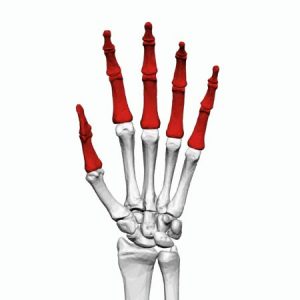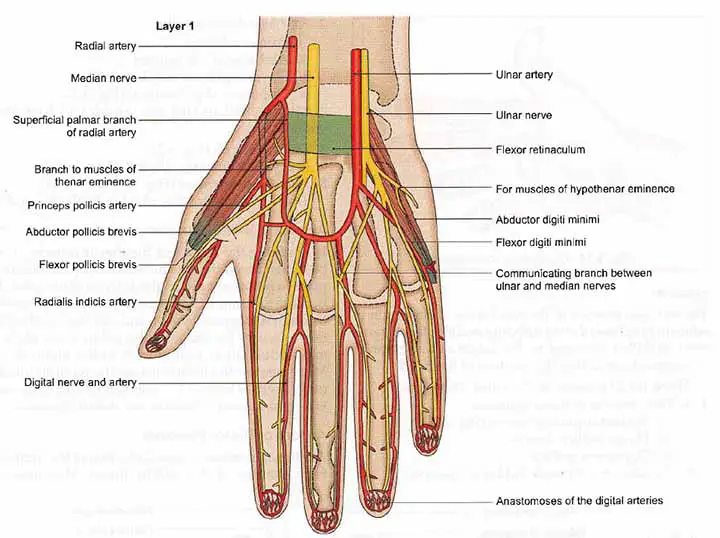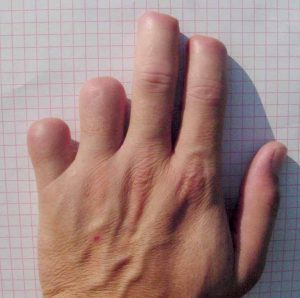Table of Contents
Index Finger Overview
The index finger is the hand’s second digit. It is one of the most frequently used digits, along with the thumb and middle finger. This finger has functional applications in sensory touch and grip, but it is also often used for expressive purposes. This is generally expressed by nonverbal hand gestures. As a result, the index finger is also known as the “pointer.” The finger is made up of three phalanges that stretch from the second metacarpal of the side. The base of the finger is provided by the proximate phalange, which attaches to the intermediate phalange through the knuckle joint. The distal phalange at the tip of the finger supports the delicate pulp of the fingertip. The palmar interosseus adducts the index finger while the extensor indicis extends it. The normal palmar artery, which branches off the palmar arch and connects the ulnar and radial arteries, delivers oxygenated blood to the finger. The median nerve innervates the skin of the finger.
Anatomy
The index finger is made up of three phalanges. The index finger lacks muscles but is regulated by muscles in the hand through tendons attached to the bones.
Phalanges
The phalanges are the bones that make up the hand’s digits and the foot’s toes. The human body has 56 phalanges, fourteen on each hand and foot. Each finger and toe has three phalanges, with the exception of the thumb and broad toe, which have only two. The fourth and fifth toes’ middle and far phalanges are always fused together (symphalangism). The hand’s phalanges are also known as the finger bones. The phalanges of the foot differ from those of the hand in that they are often shorter and more compact, especially in the proximal phalanges, which are closest to the torso.

A phalanx is named for its associated finger or toe and whether it is proximal, intermediate, or distal. Proximal phalanges are those nearest to the hand or foot. Knuckles are the prominent, knobby ends of the phalanges in the side. The metacarpophalangeal joint or metatarsophalangeal joint connects the proximal phalanges to the metacarpals of the hand or metatarsals of the foot. The intermediate phalanx is not only intermediate in position, but it is also typically intermediate in scale. The thumb and big toe lack a middle phalanx. The bones at the tips of the fingers or toes are referred to as distal phalanges. Interphalangeal articulations allow the proximal, intermediate, and distal phalanges to communicate with one another.
Each phalanx is made up of a central section called the body and two extremities.
The body is smooth on both sides, concave on the palmar and dorsal surfaces, and convex on the dorsal. It has rough areas on its sides that allow it to adhere to the fibrous sheaths of flexor tendons. It narrows from the top to down.
The proximal extremities of the first row’s bones have oval, concave articular surfaces that are wider from side to side than from front to back. Each bone in the second and third rows has a double concavity divided by a median ridge on its proximal extremity.
The distal extremities are smaller than the proximal and both end in two condyles (knuckles) separated by a shallow groove; the articular surface stretches further on the palmar than on the dorsal surface, which is most noticeable in the first row of bones.
Read Hand Specialist
The Distal Phalanx
The distal phalanges in the hand are flat on the palmar surface, thin, and have a roughened, elevated surface of horseshoe shape on the palmar surface, which supports the finger pulp. Phalanges (Hand Phalanges) Apical tufts are the smooth, wide expansions located at the tips of the distal phalanges. They have protection for the fingertip pads and nails. The thumb phalanx has a pronounced insertion for the flexor pollicis longus (asymmetric towards the radial side), an ungual fossa, and two unequal ungual spines (the ulnar being more prominent). This asymmetry is needed to ensure that the thumb pulp is always facing the pulps of the other digits, which is an osteological arrangement that provides the most contact surface withheld/grip things.
Development of the Index Finger
The number of phalanges in certain animals is often expressed as a “phalangeal formula,” which means the number of phalanges in digits starting with the innermost medial or proximal phalange. Human hands, for example, have a 2-3-3-3-3 formula, which means that the thumb has two phalanges and the other fingers each have three.
The centers for the bodies appear at the distal extremities of the phalanges, rather than in the middle of the bodies, as in the other phalanges. Furthermore, the distal phalanges are the first of the hand’s bones to ossify.
Blood Supply and Nerve Supply
The index finger is supplied by the superficial and deep palmar arch.
Though, the ulnar nerve is the main nerve of the hand. The median nerve supplies the index finger.

Venous drainage of the fingers is primarily through the superficial fascia’s dorsal venous network, which travels proximally through the dorsal aspect of the metacarpus to drain laterally into the cephalic vein and medially into the basilic vein.
The necessity of Index Finger
We cannot think of ourselves or human beings without index fingers. But is it that much necessary? We won’t answer this question directly. We’ll discuss some of the points favoring the necessity as well as some factors opposing the necessity.
Points Favouring the Necessity
Pointing Things and Objects
The index finger may be used to denote an object or an individual.
Babies begin pointing around the age of one year to convey relatively complex thoughts such as interest, desire, knowledge, and more. Human babies may illustrate the theory of mind, or the ability to consider what other people are thinking, by pointing. This gesture could serve as a foundation for the evolution of human language. Non-human primates use pointing in far simpler ways because they lack the ability to formulate thoughts about what others are thinking.
Dogs and elephants, on the other hand, recognize finger-pointing.
Greeting
Index finger used in some country such as the Netherlands for greeting.
Religious Point of View
Rising the index finger in Islam represents the Tawhid, which denotes God’s indivisible oneness. It is used to demonstrate God’s unity (“there is no god but Allah”).
Points Opposing the Necessity
The thumb, index, and middle fingers are used for precision prehension of the hand. The median nerve, which supplies the extrinsic superficialis muscles, profundus muscles, and flexor pollicis longus, is responsible for prehension by these three digits. The same nerve also supplies the lumbricals of the index and middle fingers, as well as the positioning muscles of the thumb, opponens, and palmar abductor. The median nerve also provides sensation to the three digits’ tactile surfaces.
Grip strength of the hand, in contrast to precision prehension, is mainly an ulnar nerve feature obtained through the medial three digits and the thumb. The ulnar nerve supplies the extrinsic profundus muscles of the ring and little fingers, as well as their intrinsic muscles. The ulnar nerve is also responsible for the tactile sensations in the little finger and the medial half of the ring finger. The adductor of the thumb provides the control of contra force in grip strength, and it is also supplied by the ulnar nerve.
The middle finger is regarded as the pivotal digit because it serves the needs of precision as well as power. It normally assists the index digit in matters of precision, but if necessary, it may act as the sole precision finger. When precision is not necessary, its large size and strength contribute a significant portion of the gripping power given by the medial side of the hand.
Demonstration of Unnecessity
To illustrate how useless the index finger can be, gather a pound of eight or ten penny common nails, a well-balanced hammer, and a hard log into which the nails can be driven. Begin with four rows of ten nails, each evenly spaced, with at least two inches of the nails remaining to be driven into the wood. The aim of this little drill is to solidly hit the individual nails with hard, precise hammer strokes. In nailing each row, we will use a different grip on the hammer. Keep it between your thumb and index finger, then hit each of the ten nails in turn. You’ll be around average if you get three decent hits out of ten strokes. Try again with your middle finger on the hammer. You should be able to get five solid hammer blows out of ten with this addition. If you use the ring finger, you should be able to reach eight or nine decent ones. You can get ten out of ten successful strikes if you add your little finger and hold the hammer with your whole hand. Oh, I forgot to mention that the results would, of course, be dependent on your ability to use a hammer from the start.
Let us now reverse the process. Since you can’t really carry the hammer with your little finger and thumb, you’ll need to start with your ring and little fingers, as well as your thumb. And there you have it! You can land nine or ten solid blows. Add the middle finger and notice how your strength, comfort, and accuracy increase.
It appears that strong, precise hammering does not necessitate the use of an index finger. Many manual functions involving strength can be performed by the hand without the use of the index digit. For example, with both the overlapping and interlocking grips on a golf club, the aim appears to be to keep the non-dominant hand’s index digit out of the act. Because of the way the club is carried, the dominant index finger does not grip.
Effect on Range of Motion
Interesting things happen to the hand after amputation of the index ray through the proximal portion of the second metacarpal. The range of motion of the carpometacarpal joints of the third, fourth, and fifth rays has increased. Also the comparatively immobile third metacarpal shifts more extensively at its proximal joint, indicating that its rigidity is derived in part from the second metacarpal, to which it is usually tethered by an intermetacarpal ligament.
The medial side of the hand becomes more adaptable, conforming, and expansile as movement at the carpometacarpal joints increases. Patients who have had their index rays amputated can note that their grasping range has significantly improved. Many men with average hand sizes find that after index ray amputation, they can pick up a basketball with one hand with ease. The loss of the rigidly fixed second metacarpal appears to change the grip from a three-point torque grip to a three-point bone clamp grip.
It is possible that certain manual functions may be made more complicated by the amputation of the second ray. Because of the lack of supporting bone structure, the lifting hand’s strength is undoubtedly diminished.
Amputation of the index finger at the distal interphalangeal joint results in almost complete precision loss, which is similar to functional loss of the digit because it is now just marginally longer than the thumb. As a result, a good pinch is eliminated. Only key pinching with the thumb is possible if the feeling is affected. These factors obstruct the normal operation of the hand’s remaining pieces. However, amputation of the distal phalanx can be beneficial if the person performs heavy work or requires a strong grip.

Amputation of the index in the proximal phalanx is a risk to the hand. To boost function and comfort, such amputations should be converted to ray resections in the majority of cases. A short index stump is traumatized by any use of the hand, particularly when gripping large items since the stump is located near the bottom of the thumb web. This means that any large object grasped would hit the tender stump end.
My indications for index ray resection are based on an assessment of the particular patient’s issue. I assume that physical, physiological, or functional parameters should not be used to determine who should lose index rays. I believe that this is a very personal matter in which the patient must understand his dilemma and provide the final and deciding decision for amputation.
Index Finger Summery
Of course, an anatomical structure carries certain importance and values. Some scientist believes index finger is very necessary for us. On the other hand, some believe it’s not that necessary. God created everybody parts for some purpose. Maybe we are still not that much smart or wise to discover the ultimate necessity of this finger.
Last Updated on February 23, 2022 by Learn From Doctor Team






